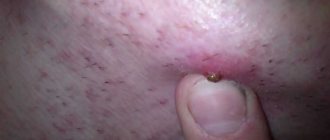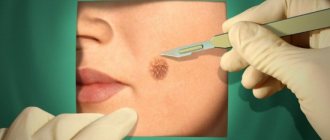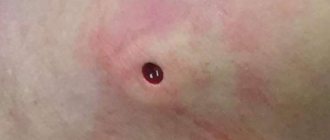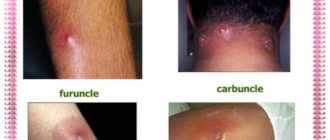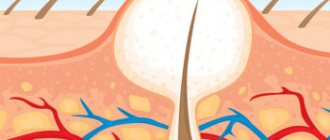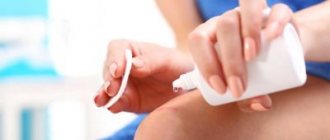A boil on the body causes a lot of unpleasant and painful sensations. The appearance of ulcers does not go unnoticed by the immune system, which begins to bombard the affected area with white blood cells. This creates pus, which eventually forms into a necrotic core under the skin. Sooner or later, the boil opens and is cleared of pus. Most often, the suppuration opens on its own, so many people are interested in what to do when the boil breaks out.
Stages and symptoms of boils
The average period for full ripening of boils is about 10 days. During this time, suppuration goes through the following stages of development.
Infiltration formation stage
Initially, an infiltrate appears on the affected area of the skin - this is a place of swelling, redness and thickening. The area is very painful, causing discomfort even from the touch of clothing, sometimes itching or causing a tingling sensation. The forming boil gradually increases in size.
Purulent-necrotic stage
In the middle of the swelling, a purulent rod forms, the cone-shaped tip of which begins to protrude above the surface of the boil. The infiltrate becomes like a dense tumor. The sore spot increases, and the inflammation of the hair follicle and the amount of pus also increases. The purulent core looks like a dirty yellow cap over the boil and can reach 2-3 cm in diameter.
The pain intensifies and sometimes becomes unbearable. Patients' body temperature rises, they feel general malaise and weakness. The skin holding the rod gradually softens and bursts. This is how the purulent contents of the boil come out, along with which a dirty bloody liquid flows out. The patient feels much better - the pain subsides, the swelling subsides, the fever goes away and the body temperature normalizes.
Healing stage
After opening the suppuration, an open wound remains in its place, sometimes quite deep. The healing time depends on the size of the lesion. The area after a small abscess heals for 3-4 days, a large boil will take more time to heal.
The boil goes through 3 main stages: infiltration, purulent-necrotic and healing stage (after a breakthrough).
Sometimes several boils merge into one large abscess called a carbuncle. The formation of a carbuncle is promoted by severe disorders of the human immune system. The pathogenic process is often formed as a result of complications of staphylococcal folliculitis.
Elimination of consequences
To eliminate the consequences of boils, you should seek medical help in time and do not try to open boils yourself. Traces of boils must be removed using local remedies. It is important to observe the rules of personal hygiene, normalize nutrition and rest-sleep regime, and take immunocorrective and vitamin-mineral complexes. It is possible to achieve adequate recovery of the body, which significantly helps to eliminate and prevent the consequences of the disease.
A lump under the skin or a hole
If a lump or lump appears after a boil, the cause may be poor hygiene and disinfection, or a tendency to form keloid scars at the wound site. The boil will swell if you apply pressure with antiseptic bandages, and the rest of the root of the abscess inside can thicken the subcutaneous tissue.
Often, compaction is a consequence of increased connective tissue healing, which is a normal process.
An atypical seal after a boil that does not go away can be eliminated by using ointments with a resorptive effect, anti-inflammatory liniments (Vishnevsky ointment, cinquefoil, ichthyol ointment). During healing, contractubex, boro-plus, and cosmetic procedures (dermabrasion, chemical peeling, laser resurfacing, “beauty injections,” needling) should be used to reduce compaction. Plastic surgery will help (if the defect is localized in the face and open parts of the body).
A hole, hole or external depression can remain when the pathology is deeply localized and the healing processes fail in an organism with reduced immunity. A depression is formed when there is insufficient external scarring. Corrected by visiting a cosmetologist and surgical correction of the defect. Secondary infection can complicate the situation; the hole should not bleed (additional diagnosis of the cause is required).
Edema
To eliminate swelling, liniments, gels, and sprays (ichthyol ointment, Vishnevsky ointment, bepanten) are used locally. Traditional medicine recipes for swelling are effective - aloe juice lotions and honey cakes can completely remove swelling.
Scar
The scar defect can be treated only with the use of surgical manipulations. Ointments like contractubex do not have the desired effect on already formed scar tissue. For mildly expressed defects, the skin can be polished using cosmetic procedures.
A scar that hurts is additionally “de-energized” from nerve endings, relieving the symptom of pain and constant discomfort in the patient (nerve blockade, intersection of branches of nerve endings).
Methods for removing scars include: laser resurfacing, chemical peeling, dermabrasion, and filler injections.
Description of the operation: during manipulation, scar tissue is excised and the edges are sutured, leaving a cosmetic suture, stimulating the natural healing of the wound surface (the suture should gradually dissolve). Excision of tissue close to the scar is rarely used. The scar can be removed only if the immune system is normalized. The color of the skin around the seam should be light and uniform. Prevention of wound infection with antiseptics is carried out until healing.
The boil has healed and reopened
If the boil has healed and reappeared, massive immunotherapy is performed. Such phenomena indicate severe disruptions in the body, incomplete previous removal of the necrotic rod. The rod may fall out on its own, but not completely. In this case, surface tension will heal, which should be checked by a specialist. It is better to get rid of such ulcers in a hospital setting under medical supervision.
Immunotherapy is carried out by taking a course of immunostimulant drugs (rioleukin, interferon, lycopid, octagam), autohemotherapy, membrane plasmapheresis, administration of staphylococcal vaccine and toxoids.
Other
In case of concomitant pathology, symptomatic, narrowly targeted treatment is carried out:
- Hair doesn't grow. Follicles do not form in place of scar tissue; the only way to solve the problem is hair transplantation (transplantation of your own or artificial hair).
- A boil can turn blue in the following situations: a bluish color indicates a deep lesion, which requires thorough cleaning of the necrotic core using surgery under general or local anesthesia. After excision, the skin around the lesion may turn blue and a red bruise may form, a superficial breakthrough or purple spot may open, which may indicate trauma to the surrounding tissues. Over time, it disappears on its own (it is possible to use traumeel gel, lifesaver, steamed cabbage leaf).
- If there are signs of tissue necrosis, you should immediately contact a surgeon; this indicates incomplete healing and the spread of necrosis from the remaining purulent component (point necrosis may appear at the site of the pathological process). It can only be cured by surgery.
Why does a boil burst?
The boil opens as it matures. Under the influence of the negative activity of staphylococci, the hair root and the sebaceous gland located next to it melt, and the affected area increases. The human immune system never stops fighting foreign microorganisms and attacks it with white blood cells. From this moment on, the boil can open at any time.
The boil begins to burst when the amount of pus reaches its maximum. In the speedy breakthrough of the abscess, the body’s defenses are of great importance.
After the boil has burst, it is necessary to free the wound from pus and treat the abscess with disinfectants and anti-inflammatory agents. When the boil has already burst, the patient's condition improves significantly.
A boil has burst - what to do?
How to treat a boil that has broken through the skin after it has fully formed? The most important thing at this stage is complete and timely treatment of the opened wound. If you do not treat the suppuration, then in place of the burst boil you can get a new problem.
Untimely treatment of an opened abscess often leads to such a complication as severe furunculosis. This disease is characterized by the fact that purulent inflammatory processes can spread throughout the body, and furunculosis cannot be cured without the help of strong antibiotics.
It is necessary to carefully ensure that the purulent core comes out of the wound. Ideally, after opening the suppuration, the rod comes out entirely, but for several more hours a small amount of fluid may flow out of the wound. Next, the opened wound must be washed with alcohol or hydrogen peroxide. It is best to treat an opened boil with bandage tampons soaked in preparations, moving from the edges to the center. Then use a new swab to treat healthy areas of skin around the wound.
Possible consequences
There are a number of negative consequences of improper treatment and treatment of a burst boil:
- The boil broke through, but was not treated with disinfectants and antibacterial drugs. There is a real danger that pathogenic microorganisms contained in the pus from the boil will infect healthy areas of the skin.
- The most dangerous possible complication after a boil bursts is blood poisoning and purulent meningitis. Suppurations on the face, neck or head should only be treated under medical supervision.
An internal boil poses a serious threat. It is located in the deep layers of the epidermis and grows not outward, but inside the human body. It is difficult for it to mature and may not break through for a long time. A boil growing inside cannot be treated at home - a surgeon must help open such suppuration.
Which doctor should I contact?
If the problem occurs in a child or a pregnant woman, a visit to a medical facility cannot be postponed. In other cases, depending on the size of the suppuration, the patient’s well-being, his age and other concomitant diseases, the problem can be treated in a hospital or at home.
A small single boil can be shown to a dermatologist or therapist.
If a boil has ruptured, it is best treated in a surgery room. A visit to the surgeon cannot be postponed. Within a few hours, all the pus will usually leave the wound, and surgical debridement will no longer make sense.
Antiseptics for drawing out pus
You can treat a burst boil with antiseptic agents after disinfecting the open wound with hydrogen peroxide. It is best to use oil-based preparations - they help the wound heal faster.
A list of remedies that are truly effective in the fight against pus from boils:
- Levomekol disinfectant paste;
- anti-inflammatory ointments - Levosin, Levomethyl, Dioksikol, Vishnevsky ointment, Ichthyol;
- antimicrobial ointments - Tetracycline, Lincomycin, Baneocin;
- stimulants that help further skin regeneration - Actovegin, Solcoseryl.
These drugs have antiseptic and healing properties. Surgeons recommend making cotton-gauze swabs, onto which ointment is applied and applied to the ruptured boil. The tampon should fit snugly against the wound, but not put pressure on it. On average, compresses with ointment must be done for another 2-4 days after opening.
An important nuance: many drugs are categorically unsuitable for treating small patients with boils.
What to do if a boil bursts on the face, neck, ear or nose? In such cases, you must immediately go to the surgeon. Delay in visiting a doctor will lead to serious complications.
Folk remedies for healing
If a boil breaks out at home, and there are no pharmacological drugs at hand, the following simple remedies perfectly relieve inflammation:
- Aloe leaf. The soft part of the plant without a dense crust must be applied to the boil that has just burst. Secure the affected area with an aloe leaf with a gauze bandage. The compress must be changed after 4 hours.
- Crushed golden mustache. A clean leaf of the plant is crushed into a pulp and placed on gauze, which is used to cover the suppuration. A new compress should be applied after 3-4 hours.
What should I do next to make the boil heal faster? You can use compresses from the roots of burdock, celandine, tansy, lubricate the wound with oil of spruce, cloves, chamomile or St. John's wort.
What to do if the pus and the core do not come out
If the boil has opened, but the stem does not come out for a long time, traditional medicine recipes will help solve the problem. The effectiveness of home recipes is due to the beneficial properties:
- Minimal harm from using improvised means.
- Fast therapeutic effect.
- Individual selection of suitable methods taking into account allergic intolerance.
A selection of the best home remedies for eliminating boils:
- Peel the garlic, pass through a press, place inside a linen cloth soaked in vegetable oil. The compress is applied to the painful area 2 times a day. Garlic will eliminate purulent secretions and relieve inflammation.
- Cut the aloe leaf in half and apply the mucous side to the wound, wrapping it with a bandage. The bandage remains for 2 hours and is replaced with a new one.
- Leaves of white cabbage and Kalanchoe are applied to the swollen subcutaneous bladder overnight.
- A burdock leaf is cut off and placed in cow's milk. The mass is brought to a boil, boiled, and applied as a bandage. Be sure to secure with a bandage.
Lotions based on medicinal herbs: St. John's wort, celandine, coltsfoot, calendula (marigold) will disinfect the wound and speed up the restoration of damaged skin. The healing tincture is diluted according to the special dosages indicated in the table:
| St. John's wort infusion | 1 tbsp. dry crushed herbs per 0.5 liters of water. The dry mixture is poured, put on gas, and brought to a boil over low heat for 15 minutes. |
| Infusion of celandine | 1 tbsp. dry herbs pour 1.5 cups of boiling water. Place on the stove, boil for 5 minutes, leave for 5 hours. |
| Infusion of coltsfoot | Add 20 grams of dry raw material to 1 glass of boiling water, leave for half an hour, filter and use 2 tbsp 6 times a day. |
| Infusion of calendula (marigold) | For 0.5 liters of boiling water take 3 tbsp. dried crushed flowers, leave for 3 hours. |
Be sure to strain the infusion through a gauze cloth.
Prohibited Measures
The problem will remain uncured if the patient does not follow simple recommendations:
- you cannot open the abscess yourself - premature or inept opening of the abscess will lead to serious complications;
- a burst abscess must not be rubbed or tried to squeeze out the purulent core; the contents of the boil must leave the body on their own;
- Mechanical impact on the burst boil should be avoided - the patient should try not to put pressure on the boil;
- antibiotics should be taken only on the recommendation of a doctor;
- Do not swim or wet a burst boil.
Such actions can cause new development of bacteria in the lesion or provoke sepsis.
Why are unexploded ulcers dangerous?
If the disease drags on and the suppuration does not clear up after 10-12 days, you need to seek help from a surgeon. There is a danger that the infection can enter the blood and internal organs of a person. As a result of a purulent formation that cannot come out, problems such as blood poisoning and purulent meningitis often develop. The main danger of an unbursted abscess is that its causative agent easily involves surrounding tissues in the inflammatory process. For example, boils on the hands can provoke diseases such as lymphadenitis or lymphangitis.
Sometimes the compaction freezes in development and turns into a hard lump that is unable to break through. In such cases, the surgeon makes an incision to remove the frozen boil.
What are the dangers of opening a boil?
Opening the inflammatory formation is an important stage in getting rid of furunculosis. It is worth knowing and remembering the consequences of the autopsy.
Lack of hygiene can lead to infectious diseases:
- meningitis;
- encephalitis;
- blood vessel thrombosis;
- thrombopheblititis.
Meningitis is an inflammatory process in the brain. Staphylococcus subsequently appears - a provocateur of inflammatory formation. Deep infections affect the inner part of the epidermis. Untimely elimination provokes the passage of pus into the brain. The disease is difficult to treat and has unexpected consequences. A person after an advanced form may remain disabled. Opening an inflammatory formation is a dangerous process. The response must be immediate.
Inflamed tissue means encephalitis. A burst purulent pimple that is not disinfected in time provokes the manifestation of the disease. The amount of pus that has remained in an open wound for a long time penetrates into the brain tissue. Illness occurs. It is worth consulting a doctor if an infectious formation occurs. Careful care will help avoid unpleasant consequences. Unexpected opening must be eliminated. It is necessary to carry out appropriate treatment. If a painful pimple occurs, it should be treated with medications. With proper management, the risk of encephalitis is reduced. You can limit yourself to a scar.
Thrombosis occurs due to the presence of a clot in the blood vessels. The rupture is fatal. Thrombosis can occur after a vein is blocked by a purulent substance. Pus forms a clot. A vein is blocked. The negative substances that make up pus cause the manifestation of dangerous diseases.
Thrombophilitis is inflammation of blood vessels resulting from infection. Inflammatory processes provoke internal problems. Vascular problems are especially dangerous. Direct connection with the heart and blood vessels form an infectious disease. Late elimination of a pleasant substance leads to unpleasant consequences, making treatment difficult and painful.
What to do to make a boil burst
The boil has matured and its contents are ready to come out. What should be done to ensure that it breaks through in a timely manner and without complications? Following the doctor’s recommendations will help to properly ripen and break through the suppuration:
- timely treatment with antiseptic and disinfectant solutions;
- applying ointments that promote rapid release of pus, for example, using a compress with Ichthyol ointment;
- using dressings that protect the open wound from surrounding germs.
Modern pharmacological drugs, when used in a timely manner, help to avoid serious consequences from a boil. However, you should try to initially prevent the appearance of ulcers on the body. The best way is always to prevent the disease - maintaining good personal hygiene, strengthening the immune system, a healthy lifestyle and a balanced diet.
Prevention of disease occurrence
To avoid the panic question: what to do if you have a boil, you need to prevent the appearance of an inflammatory formation. It is worth taking care of your health.
The main causes are: loss of immunity, hypothermia. You should not stay in a draft for a long time. Try to avoid exposure to wind when your body is wet. Inflammatory processes often occur in spring and summer. In spring, the impact is caused by a lack of vitamins, nutrients, and deceptive weather. You go in the morning - it’s cold, when lunch comes - it’s hot. Taking off a warm item and leaving sweaty skin exposed can cause an inflammatory process. In summer, swimming in the sea or in the river is dangerous. After drinking water, you need to dry your body. Should not be left to dry on its own. The resulting draft can lead to a boil.
Prevention of the disease is by taking vitamins regularly; taking one a day is not difficult. The immune system will be in good shape. Diseases will stop. You need to stick to a healthy diet and eliminate bad habits. Alcohol and smoking negatively affect the condition of the epidermis, giving it an unhealthy appearance and provoking illness. By getting rid of bad habits, you will improve your health and feel a surge of energy.
Do not squeeze purulent pimples and subcutaneous pimples. Infectious infection can cause more rashes to appear, exacerbating the situation. To remove it you need to use alcohol. By rubbing the affected areas, rid the dermis of unpleasant rashes, making it healthy, clean, and beautiful. It is not advisable to use cosmetics during treatment. The situation can be made worse. The rash will spread over large areas, causing unpleasant consequences.
Taking good care of your health will ensure clear skin. The epidermis is a reflection of the proper functioning of the system. A clean dermis is a clear sign of normal health, the absence of pathologies.
Read about: Pimples on the eyes - what are the causes?
Open wounds that appear can be treated with dried nettle. Use should be pre-soaked with water. It should infuse for an hour and a half. Should be used in the form of lotions. Remove the water and wrap the nettles in gauze. Apply periodically to the affected area. Heals the wound, eliminates the risk of infectious disease.
Chamomile tincture soothes inflamed skin, making it soft. Used for any inflammatory processes.
